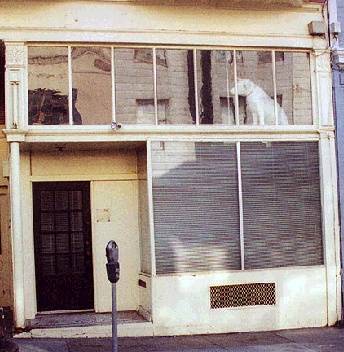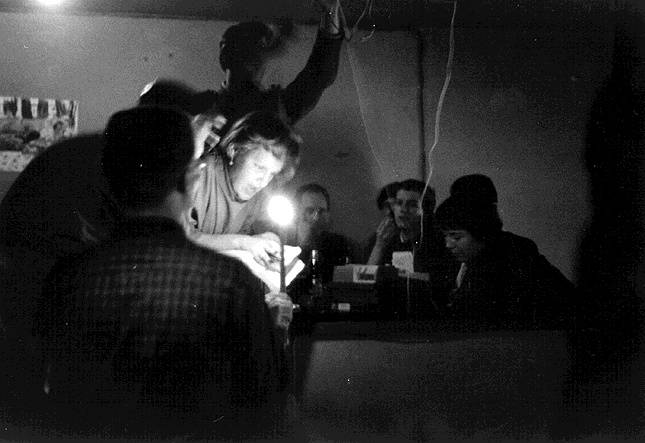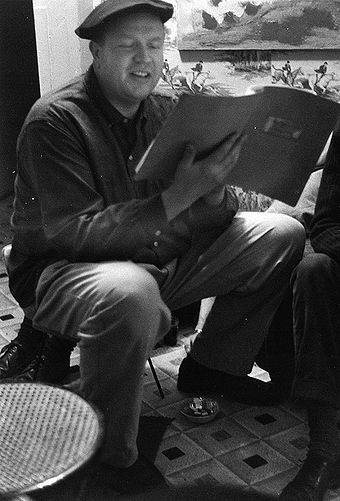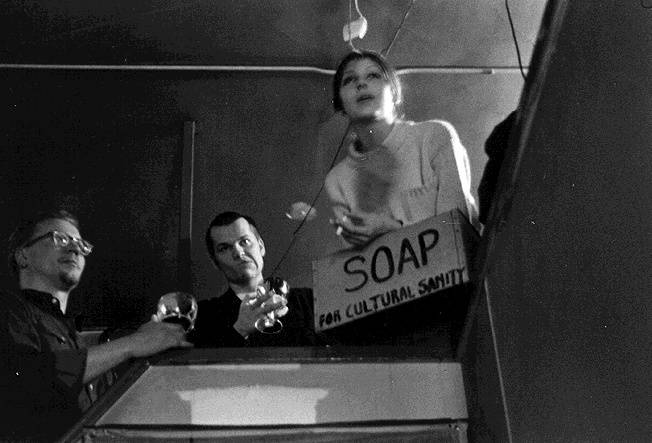The Place: Difference between revisions
m (Protected "The Place": personal account [edit=sysop:move=sysop]) |
(added photo, links, category) |
||
| Line 35: | Line 35: | ||
“A lot of it was politics,” said Krekorian. “When Nixon was vice president he was the subject of a lot of speeches. Some of these speakers were really far out. The best of them would get a bottle of free champagne. After the main speech, everybody could ask questions and there would be rebuttals; the whole bar got involved. Sometimes it was so crowded that nobody could move, and I couldn’t serve drinks—and I was in business, ya know.” | “A lot of it was politics,” said Krekorian. “When Nixon was vice president he was the subject of a lot of speeches. Some of these speakers were really far out. The best of them would get a bottle of free champagne. After the main speech, everybody could ask questions and there would be rebuttals; the whole bar got involved. Sometimes it was so crowded that nobody could move, and I couldn’t serve drinks—and I was in business, ya know.” | ||
At one Blabbermouth Night, recorded April 15, 1957, Beat celebrity “Big Daddy” Eric Nord, maverick millionaire Jeremy Ets-Hokin, Chronicle art critic Thomas Albright and comedian Irwin Cory were present, as well as other bohemian luminaries. Among those in the Blabberbox was a fellow known as Barney Google, who had a plan to run a six-inch pipe up Coit Tower that would spew a 1,000 foot beer geyser every hour on the hour. “A beer company might sponsor it,” he said. Google also advocated establishing a boundary from Montgomery up Columbus Avenue (with a detour to the west around Vesuvio and City Lights). Those crossing the boundary checkpoint would need to show a passport and pay fees of up to $100 for admission. “This will save North Beach for the Bohemians,” Google claimed. | [[Image:Eric-Nord-the-big-daddy-of-the-beatniks-c-1958.jpg|340px|left|thumb|Eric "Big Daddy" Nord, c. 1958; ''Photo: C.R. Snyder'']] At one Blabbermouth Night, recorded April 15, 1957, Beat celebrity “Big Daddy” Eric Nord, maverick millionaire Jeremy Ets-Hokin, ''Chronicle'' art critic Thomas Albright and comedian Irwin Cory were present, as well as other bohemian luminaries. Among those in the Blabberbox was a fellow known as Barney Google, who had a plan to run a six-inch pipe up Coit Tower that would spew a 1,000 foot beer geyser every hour on the hour. “A beer company might sponsor it,” he said. Google also advocated establishing a boundary from Montgomery up Columbus Avenue (with a detour to the west around [[Vesuvio Café|Vesuvio]] and [[Publishers as Enemies of the State: City Lights Books|City Lights]]). Those crossing the boundary checkpoint would need to show a passport and pay fees of up to $100 for admission. “This will save North Beach for the Bohemians,” Google claimed. | ||
The winner of the bottle of champagne at this particular Blabbermouth evening was one Big Cyn. Big Cyn told the audience she was having a hard time on Telegraph Hill because as “a German, a secretary and a virgin” she was not readily accepted. However, on receiving her prize Big Cyn confessed: “The truth is I’m French, an artist and very easy.” | The winner of the bottle of champagne at this particular Blabbermouth evening was one Big Cyn. Big Cyn told the audience she was having a hard time on Telegraph Hill because as “a German, a secretary and a virgin” she was not readily accepted. However, on receiving her prize Big Cyn confessed: “The truth is I’m French, an artist and very easy.” | ||
| Line 63: | Line 63: | ||
[[Beatniks | Prev. Document]] [[Bagel Shop |Next Document]] | [[Beatniks | Prev. Document]] [[Bagel Shop |Next Document]] | ||
[[category:beats]] [[category:North Beach]] [[category:1950s]] [[category:1990s]] | [[category:beats]] [[category:North Beach]] [[category:1950s]] [[category:1960s]] [[category:1990s]] | ||
Revision as of 15:48, 7 January 2014
Historical Essay
by Mark Schwartz & Art Peterson
"I was there..."
by Jane Juska
Original site of The Place at 1564 Grant Street.
Photo: Chris Carlsson
The Place was the home of the open readings and forums called "Blabbermouth Nights."
Photo: C.R. Snyder
Remembering the Place
Walking on Upper Grant Avenue today it would be easy to overlook the seemingly abandoned storefront at No. 1546, just two doors shy of the Filbert Steps where Dan Maccharini’s bronze seal for poets lies embossed at the corner, and next door to where Lawrence Ferlinghetti once had his print shop.
But between 1955 and 1959, this presently dilapidated building was at the center of San Francisco’s Beat culture. That’s because this was the location of The Place, a bohemian bar managed by two recent Black Mountain College alumni, Knute Stiles and Leo Krekorian. In a 1986 interview published in North Beach Magazine, Krekorian, who became known as the “Grandfather of the Beats,” explained to writer Jack Lind some of what was special about The Place: “When Jack Kerouac wrote On the Road people started hitchhiking to San Francisco from all over the country, even from foreign countries, and their first stop was The Place. They walked in with the luggage and I usually let them park their stuff a few days until they got squared away. What are you going to do?”
“I had everything at the Place,” said Krerkorian. The walls displayed the work of later well-known artists like Jay De Feo, Wally Hendrick and Robert La Vigne.
Then there were the poetry readings. “We had all the famous poets of the time. Ginsberg read his poetry in The Place. In fact, he tested out Howl in my place before it was published. Kerouac was there all the time. And (Richard) Brautigan, was only 19 when he started coming in.”
And the music. “A lot of good musicians used to come in and play. I had a piano and guys like Paul Desmond and Brew Moore would come by. It wasn’t a regular jazz place, but people would always come in and play.”
But the most celebrated aspect of the culture around The Place was probably Blabbermouth Night, where, once a week, while the rest of the nation was watching Gunsmoke, the locals—one at a time—would mount the loft—the Blabberbox—and engage in off-the cuff, spontaneous talk about anything they liked.
“A lot of it was politics,” said Krekorian. “When Nixon was vice president he was the subject of a lot of speeches. Some of these speakers were really far out. The best of them would get a bottle of free champagne. After the main speech, everybody could ask questions and there would be rebuttals; the whole bar got involved. Sometimes it was so crowded that nobody could move, and I couldn’t serve drinks—and I was in business, ya know.”
At one Blabbermouth Night, recorded April 15, 1957, Beat celebrity “Big Daddy” Eric Nord, maverick millionaire Jeremy Ets-Hokin, Chronicle art critic Thomas Albright and comedian Irwin Cory were present, as well as other bohemian luminaries. Among those in the Blabberbox was a fellow known as Barney Google, who had a plan to run a six-inch pipe up Coit Tower that would spew a 1,000 foot beer geyser every hour on the hour. “A beer company might sponsor it,” he said. Google also advocated establishing a boundary from Montgomery up Columbus Avenue (with a detour to the west around Vesuvio and City Lights). Those crossing the boundary checkpoint would need to show a passport and pay fees of up to $100 for admission. “This will save North Beach for the Bohemians,” Google claimed.
The winner of the bottle of champagne at this particular Blabbermouth evening was one Big Cyn. Big Cyn told the audience she was having a hard time on Telegraph Hill because as “a German, a secretary and a virgin” she was not readily accepted. However, on receiving her prize Big Cyn confessed: “The truth is I’m French, an artist and very easy.”
The Place could get noisy and, as the story goes, the Italian-Americans, who were still in the neighborhood, were up in arms. They didn’t want the hooting and hollering associated with the scene. So the Beats developed an alternative. They would snap their fingers as a way of paying respect to the poets and speakers, while honoring the wishes of the neighbors. This remedy must not, however, have entirely solved the problem: The poets were thrown out of The Place in 1959 because they were making too much noise.
In the early 1960s the location was taken over by students from the San Francisco Art Institute, who set up a soup kitchen and showed movies. Later, it was occupied by the shop of jeweler S Paul Gee. In 1984, graphic designer Bruce Yeleska moved into the site, joining illustrator John Mattos who had moved there two years earlier. Mattos still has an apartment at this location.
The current owner of the building has acquired Ellis Act status for the premises. But some are proposing 1546 Grant as a historic landmark. A lot of our neighborhood’s cultural history has been played out within its walls.
By Mark Schwartz & Art Peterson originally published in The Semaphore #181, Fall 2007
The Place hosting Linda Lovely and her soapbox around 1959.
Photo: C.R. Snyder
Another View of the Place
I was fascinated by the 1950s renegades, the girls who went to Greenwich Village in New York or North Beach in San Francisco and became beatniks, which meant at least to me, that they had a lot of sex. I tried to become a beatnik. I grew my hair long, and hung out in bars. But I never had sex. I never even got asked to have sex. The closest I got was one night at a bar called The Place on Grant Avenue in North Beach. The Place was small, dark, and probably dirty, though there was never enough light to find out for sure. The one waitress in The Place—Sheila was her name—appeared magically out of the darkness, holding pitchers and a tray handed to her by some sorcerer in the alley out back. No bartender was ever seen. Every Monday night was Blabbermouth Night: Anyone who wanted to could take the grungy little stage and harangue or sing or recite their poems or do magic tricks, whatever they felt like, the only requirement being a sincere attempt at being outrageous. … One night Dirty-Talking Charles, as he was known to North Beach , strode up—“weaved” is more accurate—to the stage, turned to the audience, and began to chant “Sex is the answer, sex is the answer.” On he went, never varying, never pausing, never even ending, it seemed to me. Finally, many beers within me, I called out, “So what is the question?” Dirty-Talking Charles, without missing a beat said, “Will You?” In 1956 that was a showstopper. That’s as close as I ever got to talking about sex or having some for far too many years to follow. I also failed to become a beatnik; I could never figure out what to wear on my feet, and the long braid I wore down my back gave me headaches.
by Jane Juska
From: Unaccompanied Women: Late life Adventures in Love, Sex and Real Estate by Jane Juska, Random House: 2007.




